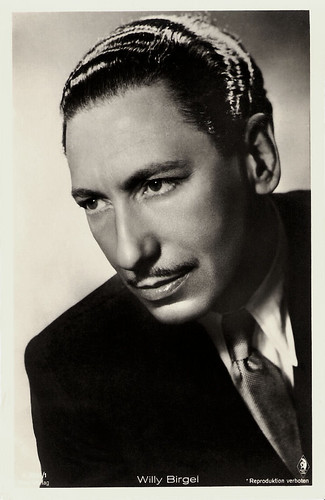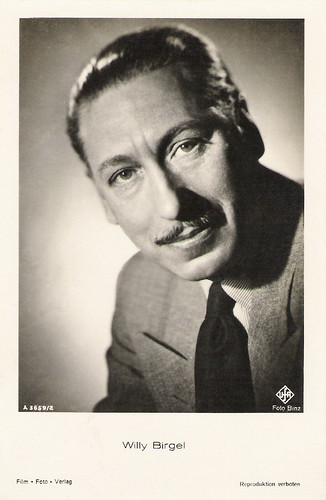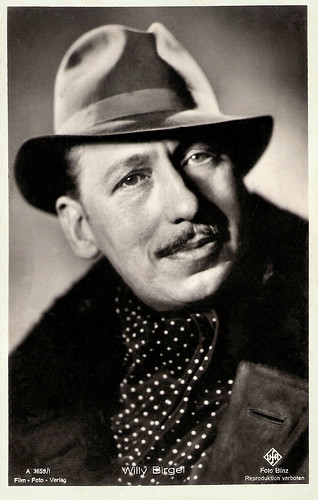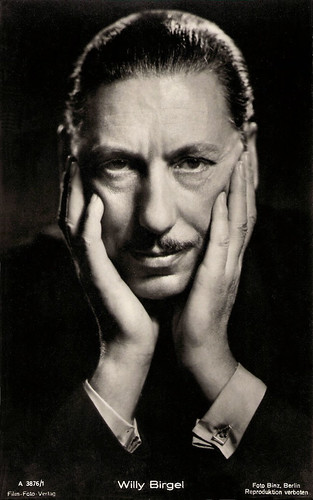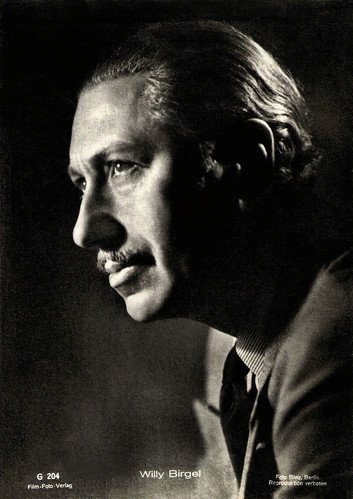The German historical film Das Herz der Königin/The Heart of a Queen (Carl Froehlich, 1940), stars Swedish diva Zarah Leander as Mary Stuart Queen of Scots and Nazi heartthrob Willy Birgel as Lord Bothwell. The film was intended as anti-English propaganda in the context of the Second World War, presenting English Queen Elizabeth I as a cold, scheming queen striving for domination, while the Scottish Mary is presented as the Queen of Hearts.
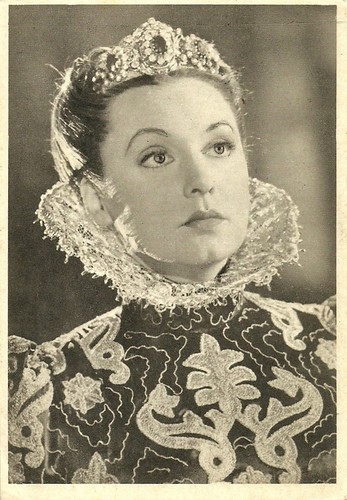
German postcard by Das Illustrierte Blatt, Frankfurter Illustrierte. Photo: Ufa. Publicity still for Das Herz der Königin (Carl Froehlich, 1940), starring Zarah Leander as Mary, Queen of Scots.
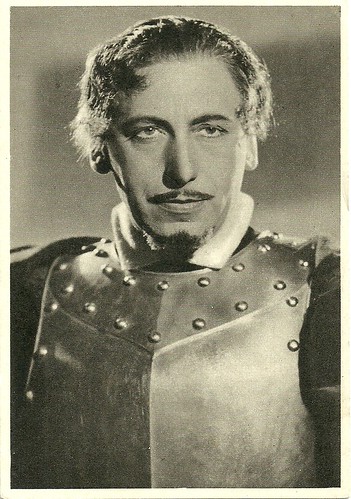
German postcard by Das Illustrierte Blatt, Frankfurter Illustrierte. Photo: Ufa. Willy Birgel in Das Herz der Königin (Carl Froehlich, 1940).
In Das Herz der Königin, Mary Stuart (Zarah Leander) is presented as the Queen of Hearts, whose actions are only led by emotions and indirectly cause her the loss of the men around her and herself too. Not only Elzabeth, but the Scottish men and women in Mary's life make her life misery as well: the evil, brutal half-brother Jacob, the coward Bothwell, the vengeful Gordon.
Scottish nobility is no positive alternative to the English court, the film suggests. This deviates from other anti-British propaganda films of the Third Reich in which e.g. the Irish or the Australians are presented as the positive, honest alternative.
The film is mostly told in flashback. It starts with Mary Stuart, Queen of Scots, held prisoner in the Tower in London and waiting for the judgement of her court case. Soon she finds out that she is sentenced to death by the scaffold on the next day. Breaking down, she recalls the events leading to her imminent death.
The flashback starts with young Mary arriving from France to Scotland, as the lawful Queen of Scots, only to encounter a strong opposition by all parties around her. First of all is her half-brother Jacob Stuart (Walther Suessenguth), who is the former Scottish ruler. He asserts that a woman is incapable of ruling the 'rough' and 'male' land of Scotland.
Also the lords, headed by Lord Bothwell (Willy Birgel), face Mary Stuart critically. Moreover, upon her arrival Mary faces an assassination attempt by Johanna (Jean) Gordon (Lotte Koch), whose clan is at feud with the Stuarts for ages. Her Privy Council refuses to show up, apart from Jacob Stuart, who tears up the document presented for his signature. When the Queen is alone again, Bothwell arrives and confesses that he had fallen in love with her. Mary orders him arrested for insulting the Queen, even though impressed by him.
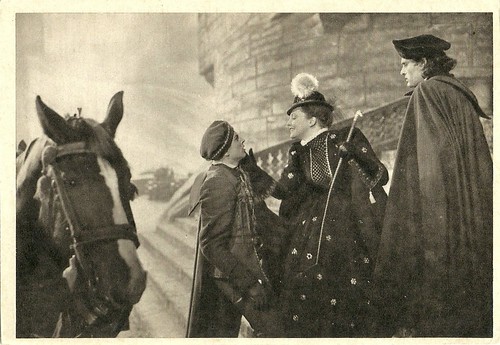
German postcard by Das Illustrierte Blatt, Frankfurter Illustrierte. Photo: Ufa. Publicity still for Das Herz der Königin (Carl Froehlich, 1940), starring Zarah Leander (standing in the middle), with on the right is Friedrich/Enrico Benfer as David Riccio, and on the left Will Quadflieg as Page Olivier.
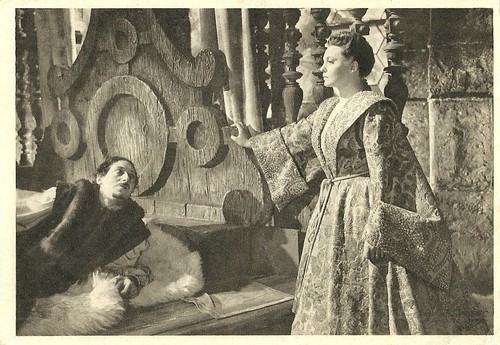
German postcard by Das Illustrierte Blatt, Frankfurter Illustrierte. Photo: Ufa. Publicity still for Das Herz der Königin (Carl Froehlich, 1940), with Zarah Leander and Willy Birgel.
Meanwhile, Queen Elizabeth I (Maria Koppenhofer), angered by the competition of the new Scottish queen and even suspecting a threat to her right to the English throne, sends her confidant Lord Henry Darnley (Axel von Ambesser), a Scottish-born dandy to Scotland to spy for her and to raise the population against Mary.
Yet, Darnley himself falls in love with Mary and leads her to Bothwell's Castle, where the Scottish lords plot the Queen's deposition. Mary ventures alone into the meeting. She is imprisoned, but released the next day on condition she will marry a Scot. Mary chooses lord Bothwell, whom she believes to be still in captivity, but who has fled with Jean Gordon and has married her. The two of them raise an army to overthrow Mary – motivated by revenge and lust for power.
The Queen is forced to marry Darnley, but becomes involved with Italian singer David Riccio (Enrico Benfer). Eventually, she gives birth to a boy child, James - the future King James I. A troupe of travelling actors stages a play, openly hinting that Riccio is the Queen's lover and might be the father of her child, so the insulted and angered Darnley has Riccio assassinated.
At this time Bothwells' army appears, which The Queen allows to enter his own Castle and temporarily take over power in the land "for the Queen's own protection". Lord Darnley has meanwhile fallen ill with smallpox. On advice of the true stern Scottish Lord Bothwell, now her lover, Mary sends her ill husband to Edinburgh, where he dies in an explosion at his home.
Queen Elisabeth sends an army to Scotland to release Mary from the power of Bothwell and to offer to her refuge in England - actually a trap meant to imprison Mary and keep her away from the throne of Scotland. Meanwhile, Mary has married Bothwell, who has separated from Gordon, but the wedding is interrupted when the English army appears under the guidance of Jacob Stuart. He presents secret love letters which Mary had sent to Bothwell while still married to her previous husband.
Olivier (Will Quadflieg), the Queen's page, is killed while trying to hide the letters. Bothwell is faced with the choice of standing by Mary and dying, or denying her. He turns away from her, but the treacherous Jacob still sentences him to death. When Jacob takes from his half-sister her only child James, to protect him against Elizabeth, Mary accepts the offer of the English Queen and goes into exile in England, which leads to her imprisonment and death.
The frame story from the beginning resumes. Mary makes peace with dying and pledges her undying love to her ladies-in-waiting, the Scottish people, and the men she loved and lost. The next morning Mary, in a stunning bejewelled gown, is led to the scaffold and kneels down in prayer as she awaits the sharp hatchet to fall.
Das Herz der Königin became a failure in its time and also today counts as one of the weakest of Zarah Leander's films.
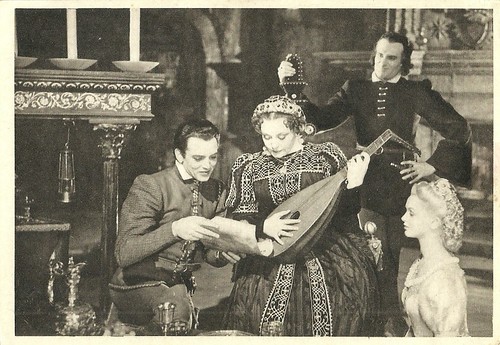
German postcard by Das Illustrierte Blatt, Frankfurter Illustrierte. Photo: Ufa. Publicity still for Das Herz der Königin (Carl Froehlich, 1940), with from left to right Will Quadflieg (Page Olivier), Zarah Leander (Mary Queen of Scots), Enrico Benfer (David Riccio), and Anneliese von Eschstruth.
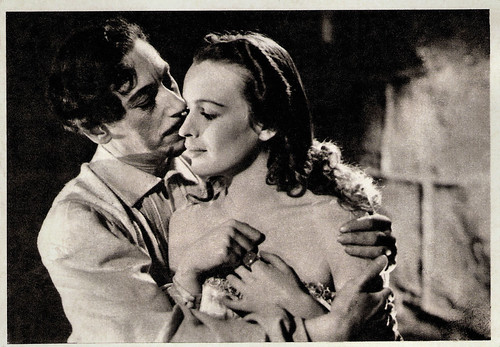
German postcard by Das Illustrierte Blatt. Photo: Ufa / Lindner. Publicity still for Das Herz der Königin/The Heart of a Queen (Carl Froelich, 1940) with Willy Birgel and Lotte Koch.
Sources: Wikipedia and IMDb.

German postcard by Das Illustrierte Blatt, Frankfurter Illustrierte. Photo: Ufa. Publicity still for Das Herz der Königin (Carl Froehlich, 1940), starring Zarah Leander as Mary, Queen of Scots.

German postcard by Das Illustrierte Blatt, Frankfurter Illustrierte. Photo: Ufa. Willy Birgel in Das Herz der Königin (Carl Froehlich, 1940).
Waiting for the judgement
Originally, the cast & crew of Das Herz der Königin were signed on to film a biopic on Catherine the Great of Russia. Zarah Leander would star in the title role, but once war broke out between Germany and the Soviet Union, Joseph Goebbels ordered the film scrapped and the production team was told to make a film about Mary Stuart instead.In Das Herz der Königin, Mary Stuart (Zarah Leander) is presented as the Queen of Hearts, whose actions are only led by emotions and indirectly cause her the loss of the men around her and herself too. Not only Elzabeth, but the Scottish men and women in Mary's life make her life misery as well: the evil, brutal half-brother Jacob, the coward Bothwell, the vengeful Gordon.
Scottish nobility is no positive alternative to the English court, the film suggests. This deviates from other anti-British propaganda films of the Third Reich in which e.g. the Irish or the Australians are presented as the positive, honest alternative.
The film is mostly told in flashback. It starts with Mary Stuart, Queen of Scots, held prisoner in the Tower in London and waiting for the judgement of her court case. Soon she finds out that she is sentenced to death by the scaffold on the next day. Breaking down, she recalls the events leading to her imminent death.
The flashback starts with young Mary arriving from France to Scotland, as the lawful Queen of Scots, only to encounter a strong opposition by all parties around her. First of all is her half-brother Jacob Stuart (Walther Suessenguth), who is the former Scottish ruler. He asserts that a woman is incapable of ruling the 'rough' and 'male' land of Scotland.
Also the lords, headed by Lord Bothwell (Willy Birgel), face Mary Stuart critically. Moreover, upon her arrival Mary faces an assassination attempt by Johanna (Jean) Gordon (Lotte Koch), whose clan is at feud with the Stuarts for ages. Her Privy Council refuses to show up, apart from Jacob Stuart, who tears up the document presented for his signature. When the Queen is alone again, Bothwell arrives and confesses that he had fallen in love with her. Mary orders him arrested for insulting the Queen, even though impressed by him.

German postcard by Das Illustrierte Blatt, Frankfurter Illustrierte. Photo: Ufa. Publicity still for Das Herz der Königin (Carl Froehlich, 1940), starring Zarah Leander (standing in the middle), with on the right is Friedrich/Enrico Benfer as David Riccio, and on the left Will Quadflieg as Page Olivier.

German postcard by Das Illustrierte Blatt, Frankfurter Illustrierte. Photo: Ufa. Publicity still for Das Herz der Königin (Carl Froehlich, 1940), with Zarah Leander and Willy Birgel.
Motivated by revenge and lust for power
Meanwhile, Queen Elizabeth I (Maria Koppenhofer), angered by the competition of the new Scottish queen and even suspecting a threat to her right to the English throne, sends her confidant Lord Henry Darnley (Axel von Ambesser), a Scottish-born dandy to Scotland to spy for her and to raise the population against Mary.
Yet, Darnley himself falls in love with Mary and leads her to Bothwell's Castle, where the Scottish lords plot the Queen's deposition. Mary ventures alone into the meeting. She is imprisoned, but released the next day on condition she will marry a Scot. Mary chooses lord Bothwell, whom she believes to be still in captivity, but who has fled with Jean Gordon and has married her. The two of them raise an army to overthrow Mary – motivated by revenge and lust for power.
The Queen is forced to marry Darnley, but becomes involved with Italian singer David Riccio (Enrico Benfer). Eventually, she gives birth to a boy child, James - the future King James I. A troupe of travelling actors stages a play, openly hinting that Riccio is the Queen's lover and might be the father of her child, so the insulted and angered Darnley has Riccio assassinated.
At this time Bothwells' army appears, which The Queen allows to enter his own Castle and temporarily take over power in the land "for the Queen's own protection". Lord Darnley has meanwhile fallen ill with smallpox. On advice of the true stern Scottish Lord Bothwell, now her lover, Mary sends her ill husband to Edinburgh, where he dies in an explosion at his home.
Queen Elisabeth sends an army to Scotland to release Mary from the power of Bothwell and to offer to her refuge in England - actually a trap meant to imprison Mary and keep her away from the throne of Scotland. Meanwhile, Mary has married Bothwell, who has separated from Gordon, but the wedding is interrupted when the English army appears under the guidance of Jacob Stuart. He presents secret love letters which Mary had sent to Bothwell while still married to her previous husband.
Olivier (Will Quadflieg), the Queen's page, is killed while trying to hide the letters. Bothwell is faced with the choice of standing by Mary and dying, or denying her. He turns away from her, but the treacherous Jacob still sentences him to death. When Jacob takes from his half-sister her only child James, to protect him against Elizabeth, Mary accepts the offer of the English Queen and goes into exile in England, which leads to her imprisonment and death.
The frame story from the beginning resumes. Mary makes peace with dying and pledges her undying love to her ladies-in-waiting, the Scottish people, and the men she loved and lost. The next morning Mary, in a stunning bejewelled gown, is led to the scaffold and kneels down in prayer as she awaits the sharp hatchet to fall.
Das Herz der Königin became a failure in its time and also today counts as one of the weakest of Zarah Leander's films.

German postcard by Das Illustrierte Blatt, Frankfurter Illustrierte. Photo: Ufa. Publicity still for Das Herz der Königin (Carl Froehlich, 1940), with from left to right Will Quadflieg (Page Olivier), Zarah Leander (Mary Queen of Scots), Enrico Benfer (David Riccio), and Anneliese von Eschstruth.

German postcard by Das Illustrierte Blatt. Photo: Ufa / Lindner. Publicity still for Das Herz der Königin/The Heart of a Queen (Carl Froelich, 1940) with Willy Birgel and Lotte Koch.
Sources: Wikipedia and IMDb.
